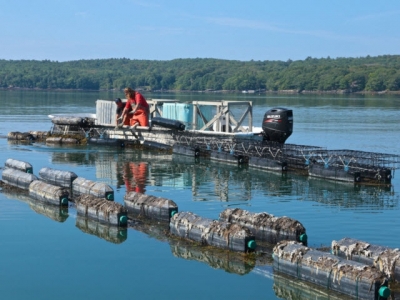Maine oyster farmer stares down climate change, learns to adapt - Part 2

Mook Sea Farm, on the Damariscotta River in mid-coast Maine, is adapting to risks associated with climate change. Photo courtesy of Mook Sea Farm.
Business boom
At that time, market demand for oysters grew and kept growing, and Mook Sea Farm developed technology to grow microalgae to feed the larvae that also led to better performance for the hatchery. Mook also improved its grow-out operation. Instead of growing oysters to market size on the bottom of the Damariscotta River, the company now uses grow cages suspended in the water column.
And as Mook Sea Farm became better at producing oysters, demand for oysters boomed. In 2010, Mook had four employees. Now there are 22 full-time employees and several part-timers.
“The advantage to having brought the company to this size is that it does give you the resources and ability to, instead of reacting to a crisis when it’s almost too late, to look down the road,” said Mook.
Last year Mook hired research scientist Meredith White to lead the company’s research and development effort, get ahead of problems and find solutions. White studied biological oceanography and the biological effects of ocean acidification while earning her Ph.D. in a joint MIT/Woods Hole Oceanographic Institute program.
For the first 24 hours of its life, White explained, a larval oyster can’t eat. It is developing feeding organs and its shell, and is entirely dependent on the finite supply of energy from the food in its egg.
Scientists can measure the amount of calcium carbonate building blocks available in the water. If it’s low, it means the larval oyster has to use more energy to make its shell and diverts energy from another function – thus their health and possibly survival is affected.
Warning signs of climate change
White and Mook met in 2014 while serving on Maine’s Ocean Acidification Commission, the first state-level commission on the East Coast. Mook also collaborates with academic researchers, like Joe Salisbury at the University of New Hampshire, who in 2014 developed and installed the sophisticated monitoring equipment in the hatchery.
White is planning a study to help determine whether increasingly acidic seawater will harm oysters as they grow in the wild from seed to market size.
If ocean acidification harms older oysters, Mook wants to know so he can warn the rest of the East Coast oyster farming industry.
“These changes that we’re seeing that cause the problem with the larvae are inexorable changes that [society has not addressed],” said Mook. “So presumably at some point those changes are not just going to impact the larvae, but impact the juveniles. Our goal is to understand when and if that happens and how to prepare for it. Let’s try to answer the question: Is this something we need to be concerned with, or not?”
The study would look at juvenile to adult oysters grown from Mook seed oysters – so they’ll have the same genetics – under three different water chemistry scenarios in two locations: the Damariscotta River and Chesapeake Bay.
Let’s try to answer the question: Is this something we need to be concerned with, or not?
They will look at how the juvenile older oysters perform while monitoring the water’s saturation state – a measure of how much of the building blocks for calcium carbonate is in the water. The three scenarios are: untreated seawater, seawater with the addition of carbon dioxide and seawater with the addition of air with the carbon dioxide removed from it.
Lab studies have shown that older oysters can be affected by ocean acidification, but this effort would examine that question in the field.
“What’s the tipping point?” said White. “We just don’t know that. Maybe it isn’t going to be a problem, but we don’t know and we’d like to know because we’d like to be able to plan for it.”
Mook’s industry partner is Chesapeake Bay Holdings, which operates a hatchery in Grimstead, Va., in waters that have a different chemical composition, including lower salinity, than the Damariscotta River.
“It will let us look at the response in two different systems that have very different water chemistry,” said White.
They are collaborating with academic partner Salisbury.
The study would need about $300,000 in funding over two years if it is to begin in the summer of 2019. They’ve requested funding through NOAA Fisheries Saltonstall Kennedy Grant Program.
Related news
 Understanding water quality variables for aquaculture
Understanding water quality variables for aquaculture Differences in the units (dimensions) by which water quality variables are reported can result in confusion and sometimes lead to faulty assessments
 Factors affecting efficiency of commercial fertilizers in aquaculture
Factors affecting efficiency of commercial fertilizers in aquaculture Aquaculture is becoming increasingly intensive through application of feeds and often with supplemental mechanical aeration.
 Maine oyster farmer stares down climate change, learns to adapt - Part 1
Maine oyster farmer stares down climate change, learns to adapt - Part 1 Ocean acidification tops the list of climate change effects that shellfish growers face because it can impair shellfish larvae from properly forming their shell